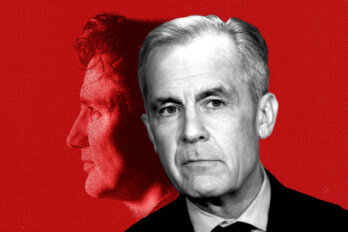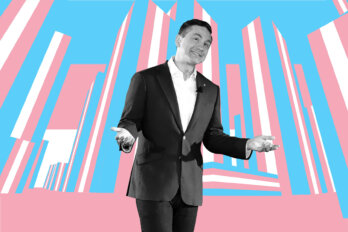Of all the genres wrought by our digital age, none is quite so insufferable as the political fundraising email. In the past month, Conservative Party bagman Irving Gerstein implored supporters: “For the good of our country, we need to hold Justin Trudeau to one term only,” asking for a minimum donation of $35. The NDP reported: “We call out hypocrisy and scandal (after scandal!),” berating the Liberals’ fat-cat fundraisers and suggesting a minimum donation of $100.
As cloying as they can be, those fundraising emails seem to be working. In the previous quarter, the Conservatives raked in $3 million, while the NDP pulled in $1 million—two respectable totals. The cores of both parties seem energized. Both the Conservatives and the NDP have been taking dead aim at the finance minister for his (supposed) ethical misdeeds and (alleged) attack on small business. And the faithful feel like they finally have the governing Liberals on the ropes.
But, fundraising aside, neither party has made much headway against Trudeau. In a poll-of-polls summary by the CBC’s Éric Grenier, the Liberals are sitting almost exactly where they were on election day in 2015. Losses of support in the Prairies have been more than offset by improved numbers in Quebec. At this rate, Trudeau is steamrolling toward a second majority government, perhaps even larger than his current one. His favourability rating is sitting at plus four—not too shabby at mid-mandate, just as fatigue is beginning to set in but before the party has properly begun its pitch for re-election.
It’s against that tide that the opposition parties are struggling. Under interim leaders, both parties contributed thoughtfully to debates around assisted dying and cannabis legalization. But now both parties have more permanent leaders: Andrew Scheer, the thirty-eight-year-old compromise choice in a brutal leadership campaign; and Jagmeet Singh, the also-thirty-eight-year-old rising star and first-ever non-white elected leader of a federal political party. Both enjoy an approval rating of roughly one-third of the country, with more than four in ten saying they don’t know how to feel about the thirty-eight-year-olds.
That’s not great. For all the fanfare about these young leaders and their apparent ability to motivate the masses, disenchanted by Trudeau’s broken promises of hope and change, they’ve barely managed to edge the needle forward. So, as 2017 drew to a close, we put this question to two prominent MPs in both caucuses: Just what do you have to do to break through?
Conservative Immigration critic Michelle Rempel is, unsurprisingly, optimistic about her party’s current standing. While she admits her party hasn’t gained ground on the Liberals, she also notes they haven’t fallen back. More importantly, she adds, they’ve gone after Trudeau and his cabinet on a host of different issues. On policy, from the economy to immigration to marijuana legalization, she says: “We moved the dial.”
Of course, any politician will say that. But Rempel is at least a little more forthcoming about a year that saw her party go from a leaderless 33 percent to a
Scheer-led . . . 33 percent. Her party still sits at the wrong end of a ten-point gap behind the Liberals. It just lost a crucial suburban Vancouver riding in a by-election upset.
“Did we do a fantastic job?” Rempel asks rhetorically, as to whether her party had convinced voters in 2017 that they are ready to take power. (No, was the implicit answer. But she says they did “good.”)
Alexandre Boulerice, the NDP’s finance critic, didn’t try too hard to spin his party’s distant-third-place polling position. He—charitably—calls 2017 a “difficult year” for his party. “We did okay,” he tells me. “We held the fort.” Even that, though, is debatable: the NDP have lost more ground since their disappointing 2015 performance.
For the Conservatives, 2018 will be about taking aim at the smiling, happy prime minister without hurting itself in the process. To that end, Scheer is hoping to take a page out of the late Jack Layton’s book, styling himself as the happy warrior. Immigration, Rempel’s file, is a fine place to start.
While immigration might not be front of mind for most people, it is arguably one of the largest public policy issues to unfurl under Trudeau, and an excellent microcosm for his tenure thus far as leader. From an ambitious resettlement of those fleeing violence in Syria and Iraq, to the wave of illegal border crossers seeking asylum in Canada, to Ottawa’s decision to gradually boost immigration targets to 340,000 new arrivals per year by 2020—it’s big, transformative stuff. Rempel’s criticism takes aim more at how that is being done than that it is being done. She chides the lack of language training, the lack of affordable housing, the lack of planning for job placement or training. “Immigration is not orderly and planned anymore,” Rempel tells me.
The Conservatives’ criticism hasn’t appeared to hit home yet. In a recent Leger poll, when asked in what field they felt the Trudeau government has had the strongest performance, 15 percent of voters said “welcoming more refugees,” making it the third-most popular option on the list. And Trudeau himself, of course, got a bump from the barrage of images of him welcoming Syrian refugees to Canada. Rempel’s mission is to show that, for all the photo ops, the Trudeau government has not managed that influx of refugees as seamlessly or compassionately as it would have you believe.
But focusing on immigration can be a risky proposition. It is all too easy for criticism of an immigration system to bleed into growing xenophobic sentiment. The Conservative Party seems at least somewhat attuned to the fact that pushing on migration too hard could be mistaken for dog-whistle politics. It has reason to be alive to that risk: just this year, leadership contender Maxime Bernier suggested deploying the military to stop border-crossers, while his rival, Kellie Leitch—cribbing from Donald Trump’s immigration playbook—ran with a hard-right tone, promising to limit immigration overall and vet would-be immigrants for undefined “Canadian values.” Her campaign was endorsed by several white supremacist figures across Canada.
Rempel bristled at the mention of Leitch’s rhetoric. “Kellie Leitch’s campaign was repudiated by our party,” she says. “And she no longer has a seat in our shadow cabinet.” Leitch was, indeed, routed in that leadership race, picking up just 7 percent on the first ballot and finishing behind centrist Michael Chong. Leitch is now facing a nomination challenge from within her party in her own Ontario riding of Simcoe–Grey.
Scheer himself has opened himself to attacks from the other parties by tapping Hamish Marshall, a former director at the alt-right Rebel Media, as the chair for his 2019 election campaign. Scheer’s priorities, from railing against Ottawa’s settlement with child soldier-cum-Guantanamo detainee Omar Khadr to harping on the supposed assault on free speech on university campuses, run parallel with many obsessions for the Ezra Levant–founded Rebel Media.
Rempel rejects the comparison to the Rebel. “I think it’s a stretch to paint our party as angry,” she says.
Stretch or not, the Conservatives seem aware of the dangers of looking dour next to Trudeau’s sunny ways. Scheer’s party, after pressure, have recently announced that Scheer will no longer appear on the Rebel. The party has also worked to portray the leader as a friendly, jean-wearing Everyman—witness November’s impossibly awkward meet-the-neighbours TV ad.
Conservatives haven’t, generally, done well when they run on social issues. They much prefer to tout their fiscal bona fides. But with the economy doing relatively well, all things considered, they might not have much of a choice but to focus more on issues like immigration, health care, and perceived social ills. To that end—as Leitch’s campaign illustrated—there is a temptation to cross streams with the increasingly vocal right-wing fringe of the political spectrum. In 2018, Scheer will need to figure out if he can beat Trudeau’s sunny vision with his own.
The NDP’s big priority in 2018 will be to finally figure out how to juggle its constant concern with keeping its Quebec beachhead while growing in the rest of the country. In the 2015 election it tried to do both—and ended up doing neither.
The NDP have been in an unenviable position since the federal election of 2011, caught between an uneasy designation as the heir to the Bloc Quebecois’ provincial fortunes and the will to be a serious contender for national power. In the process, they’ve had to straddle the ideological divide between Quebec and the rest of Canada—or at least attempt to.
The Netflix tax is a nice illustration. Wander into any Tim Hortons in Moose Jaw and mention the Netflix tax, and you’ll draw scoffs. The tax, depending on who you’re talking to, is either a proposed levy specifically for online subscriptions or a proposition to simply add the 13 or 15 percent HST onto those online purchases. Quebec has recently proposed the latter, only to have Heritage Minister Mélanie Joly rule out any such move.
Not surprisingly, the tax was one of the first things Boulerice brought up when I spoke to him. “It’s unfair for taxpayers,” the finance critic says, to not charge the same tax that applies everywhere in Canada to the internet. His NDP have recently announced that it would apply the sales tax to Netflix, a position sure to draw cheers in Quebec and jeers elsewhere in the country. It feels, increasingly, that NDP positions can be fit into two boxes: decisions sure to help its Quebec base, and decisions sure to hamper it.
The niqab is another flashpoint in the Quebec–national divide. Look again to the 2015 election, when Thomas Mulcair’s level of opposition to a provincial ban on the niqab for public servants appeared to depend on where he was and in what language he was asked. Trudeau’s outright and bombastic opposition to the ban was, if nothing else, consistent, and he ended up scooping up a bunch of NDP seats in Quebec. Two years later, the NDP’s leader has not just railed against the niqab ban, but is a guy—as someone who wears both a turban and kirpan—who could be personally impacted by some of the religious neutrality laws that have been proposed on the Quebec political scene.
Yet the Quebec wing of the party is clearly uncomfortable with Singh’s rhetoric on the niqab ban—a ban which continues to poll well among voters in that province. Boulerice himself told Le Devoir, in September, that “Mr. Singh has a relatively extreme position when it comes to the defence of individual liberties.” Caucus-mate Pierre Nantel openly mused about quitting the party, saying Singh’s position on the niqab would interfere with Quebec’s special political status within Canada; rumours abounded that some MPs were considering defecting to the Bloc Québécois. In the meantime, Singh’s position on the niqab was going over quite well in the rest of the country.
Now, Boulerice has changed his tune.
“Myself, Pierre Nantel, we are really happy in the caucus,” he tells me. He admits that there have been “tensions,” however, and that those are likely to continue. But introducing Singh to Quebecers properly, he feels, would make a big difference. “Of course we will have to send him to Tout le monde en parle,” Boulerice says, of the wildly popular Radio-Canada talk show that has been known to make, and break, political careers.
When I ask Boulerice to expound on some of the issues his party will champion in the next year, he easily rattles them off: expanding healthcare coverage to prescription drugs and other benefits; a $15-an-hour minimum wage for federal workers; building social housing; targeting tax havens; opposing pipelines. These, I remind him, were the core tenets of the NDP’s platform for the 2015 election. The election where they snatched defeat from the jaws of victory, falling from first place on the first day of the race to a distant third on election day. Many of those issues, too, have been co-opted by the Liberal Party. Why would someone vote for the NDP now when they hadn’t voted for them in 2015?
Boulerice, admitting that they’ve yet to sketch out exactly which new policies they’ll focus on for the next election, points to Singh as an important draw. His party is also banking on voters being disenchanted with Trudeau’s lack of progress. “He’s speaking a lot but not taking real action.” Whether or not voters agree with Boulerice on that point remains to be seen.
Of course, Trudeau might be his own worst enemy. There’s no shortage of booby traps the first-term prime minister may yet trip in the coming year, thereby leaving one of the opposition parties with an opening. Marijuana legalization is set for this summer. The erratic president of the United States could throw any number of curveballs. Trudeau could be pilloried for signing, or not signing, any number of the trade agreements currently up for consideration. And so on.
The two main opposition parties could sit around and wait for the prime minister and his government to trip up. By and large, that seems to be their current tactic, judging by the ferocity with which they’ve glommed on to finance minister Bill Morneau’s supposed ethical failings—his failure to report a registered French company to the Ethics Commissioner and his decision not to put his substantial assets into a blind trust. Yet both parties appear to be figuring out that the tried-and-true line of partisan attacks doesn’t appear to be working on this prime minister.
Unprompted, Boulerice tells me his party’s efforts to focus on Morneau may have been myopic. “The stories didn’t really change how people perceive the Liberal Party,” says Boulerice. He seemed to be hinting that, once the new year rolls around, the NDP will be switching gears.
Rempel, for her part, goes long, delving into a lengthy treatise on future technologies that could revolutionize the entire economy. Blockchain, automation, artificial intelligence, big data. Trudeau has been quick to champion these technologies and fund innovative research projects, but he is far from having any sort of strategy on that front. “The party that is going to be the most successful with the public in the next ten years is going to be the party that understands all of these challenges,” says Rempel.
She isn’t suggesting that her party is there yet—by any measure, it isn’t—but her words nevertheless provide interesting instruction in a political landscape where all parties seem so mired in the current state of affairs they can’t seem to look to the horizon.




